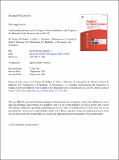Understanding the interaction of organic corrosion inhibitors with copper at the molecular scale : benzotriazole on Cu(110)
Abstract
Benzotriazole (BTAH) has been used for several industrial applications, but most commonly as a corrosion inhibitor for copper, since the 1950s. However, the mechanism of its interaction with copper surfaces at the atomistic scale is still a matter of debate. Here, the adsorption of BTAH onto a clean Cu(110) surface has been investigated by a combination of scanning tunnelling microscopy, X-ray photoelectron spectroscopy, high resolution electron energy loss spectroscopy and density functional theory calculations. Different supramolecular structures have been observed depending on molecular coverage and annealing. In the low coverage regime, flat lying deprotonated species are formed which give way to benzotriazolate molecules in an upright configuration by increasing the BTAH exposure. The ensuing monolayer is self-limiting but, upon annealing above 150 °C, transforms into a highly ordered nano-ridge structure resulting from a significant in-plane and out-of-plane reconstruction of the surface. All structures are characterised by a strong molecule-substrate interaction and the high coverage phases are dominated by the formation of metal-organic complexes between copper adatoms and benzotriazolate species. These findings shed light on the nature and strength of the interaction occurring between BTAH and copper which lies at the basis of the effectiveness of this prototypical corrosion inhibitor.
Citation
Turano , M , Walker , M , Grillo , F , Gattinoni , C , Edmondson , J , Adesida , O , Hunt , G , Kirkman , P , Richardson , N V , Baddeley , C J , Michaelides , A & Costantini , G 2021 , ' Understanding the interaction of organic corrosion inhibitors with copper at the molecular scale : benzotriazole on Cu(110) ' , Applied Surface Science , vol. 570 , 151206 . https://doi.org/10.1016/j.apsusc.2021.151206
Publication
Applied Surface Science
Status
Peer reviewed
ISSN
0169-4332Type
Journal article
Description
M.T. gratefully acknowledges financial support from Lubrizol Limited and, together with J.E., thank the Engineering and Physical Sciences Research Council (EPSRC) grant EP/L015307/1 for the Molecular Analytical Science Centre for Doctoral Training (MAS-CDT). C.G acknowledges the Euler cluster managed by the HPC team at ETH Zurich for computational resources and is grateful for computational support from the UK national high performance computing service, ARCHER, for which access was obtained via the UKCP consortium and funded by EPSRC grant EP/P022561/1.Collections
Items in the St Andrews Research Repository are protected by copyright, with all rights reserved, unless otherwise indicated.

